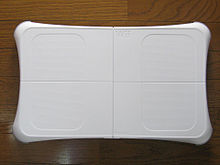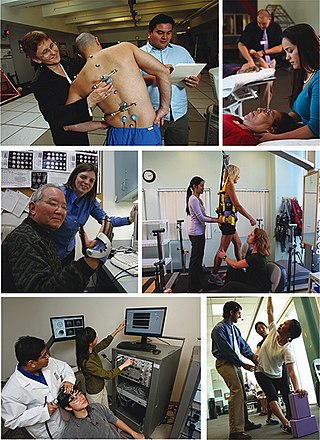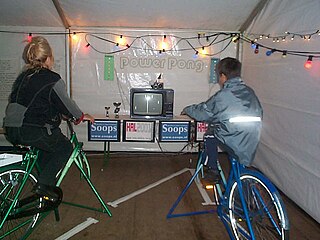Results

Timed Up and Go test (TUG) scores have been seen to improve after having engaged in gaming rehabilitation. Several studies have produced output that suggests that Wii games are able to effectively increase patients' scores after a certain period of rehabilitation through them. [29] [30] Stroke recovery patients and patients with an Acquired brain injury are two such examples of this output. Both patient classes have been shown to display slightly better improvements when using the Wii game or Wii balance board than when engaging in regular therapeutic methodologies. Continuing past these classes, studies are continually proving that these scores can be increased in a variety of patients with a variety of physical disabilities and from a variety of backgrounds.
In recent studies, professionals have proven that the therapist and patient create a positive relationship during physical rehabilitation with video games. [31]
Balance and energy expenditure are other great improvements seen amongst patients of gaming rehabilitation methods. Methods such as using the Wii Fit board and Wii Sports games have proven effective at increasing these numbers amongst a variety of patients. Elderly and cerebral palsy patients have been the focus of these outputs, as both have the ability to improve these categories of their lives. Specifically, elderly have been shown to display poor balance and mobility due to aging conditions, resulting in a need for rehabilitation intervention [32] [33] and cerebral palsy patients display a combination of poor posture and poor balance which result in a need for therapy, as well. [34] [35] Both, after a period of engaging in a variety of Wii-based games, have shown improvement comparable to, or better than, what they display during regular methodologies, gaining support for these systems. Specifically, for the elderly community, interactive video-game based system exercise on the balance can improve balance after 6 weeks of implementation [36] Elderly patients with Parkinson's disease showed improved performance in activities of daily living after 14 sessions of balance training, with no additional advantages associated with the Wii-based motor and cognitive training. [37]
Finally, motor-skill rehabilitation has been proposed as another possible way in which games can be used for rehabilitation purposes. Stroke patients with upper extremity motor difficulties have been the primary focus of this subject and, in this case, a variety of gaming environments have been experimented with. Output has shown that their Fugl-Meyer UE scores and their Functional Independence Measure scale score increase after a period of engaging in virtual rehabilitation, suggesting that their mobility dysfunction decreased and their degree of independence increased due to the intervention. [38] Additionally, output has suggested improved motor skills on a higher level, having several researchers suggesting positive improvements in their stroke patients as a result of virtual rehabilitation methods. [39] At this higher level, researchers have suggested improved ability to walk, or ambulation, and improved use of larger motor skills after intervention. One other class of patients that has been studied less frequently in this category of rehabilitation is cerebral palsy patients. Ability to walk certain distances without the use of an assistive device was the method of measurement for this category. After a period of working with a Wii-based system, it was shown that a patient who struggled with walking large distances before, was able to walk a noticeably longer distance. [34] This suggests an improvement in larger motor skills, whereas the stroke patients demonstrated an improvement in finer motor skills, focused strictly on their use of upper extremities during the gaming rehabilitation.
Negative results
If by one hand rehabilitation through gaming may be beneficial since it can improve motivation to the rehabilitation and reduce distraction from the routine of a tedious medical treatment, injuries arisen from excessive gameplay have been occasionally reported, such as tendonitis, dislocation of patella or hand laceration. A recent study proves that when incorporating video games into a patient's therapy routine can increase their chance of developing musculoskeletal. [40] Although these injuries might be occasional or rare, a large scale study would be needed to investigate the occurrence of these damages facing the millions of users of games worldwide. [41]
It's also been suggested that the use of gaming systems for home-based rehabilitation may promote a lack of communication between the therapist and the patient. [42] [43] In these cases, it is difficult to track the progress of the patient appropriately, and the effects of the therapy are unknown. It's also possible in these scenarios that a lack of tracking also increases time spent on task, since the therapist does not properly see what level the patient is performing at. Another challenge in video game rehabilitation, can result to lack of computer skills on the part of therapists, lack of support infrastructure, expensive equipment, inadequate communication infrastructure, and patient safety concerns. [44]
Additionally, common effects of virtual reality environments, such as dizziness, nausea, and disorientation, have also been found to result in the case of rehabilitation through these methodologies. As these scenarios work the same as other virtual reality scenarios, they are not exempt from the negative results that can be seen across the board from these sorts of systems, and patients have shown this to be evident. Virtual reality systems have also proven difficult to maintain and sanitize after use, which has caused some to stray away from their use and stick to regular methodologies instead. [45]
Finally, gaming technology is believed to promote physical activity on clinical populations with multiple sclerosis, although there is no consensus about training duration, intensity or outcomes used to assess the clinical effectiveness, which suggests that randomized controlled trial should be carried out comparing gaming technology to traditional exercise for this population. [46] Similarly, the same can be said with results in the field of video game rehabilitation with elderly patients. While there are consensus's being built, there are still some results that seem insignificant in their findings and remain inconclusive either way. [33] There is not much data available about adverse results such as falls when using video games as part of rehabilitation. [47]






